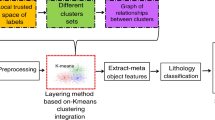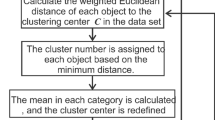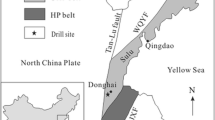Abstract
Rock mass joint set identification, crucial for geological and geotechnical studies, is often based on stereographic projection. However, the related software programs can eventually present some access limitations. Therefore, with the development of the Artificial Intelligence field and the sharp increase in Machine Learning and Deep Learning applications, this study aims to suggest an alternative solution for rock mass joint sets identification based on the K-means clustering algorithm, an unsupervised Machine Learning model that aims to structure unlabeled data into different clusters based on their patterns. The study includes a comparative analysis of joint set clustering using the K-means model and the stereographic projection. The two methods are applied to the structural data of the Draa Sfar deep underground mine in Morocco. The results show the concordance of the joint set clustering using both stereographic projection and the K-means model, highlighted by the mean dip and dip direction obtained values. This concordance confirms that K-means clustering allows identifying rock mass joint sets if access to stereographic projection automated tools is limited. However, using K-means clustering for this purpose requires applying preprocessing methods such as the elbow method or the silhouette score to identify the clusters' number previously. In conclusion, unsupervised learning can be an alternative for identifying rock mass joint sets as long as enough and suitable structural data are accessible.







Similar content being viewed by others
Data availability
The data set used in the current study is available from the corresponding author on reasonable request.
References
Abdelouhed F, Algouti A, Algouti A, Mohammed I, Mourabit Z (2021) Contribution of GIS and remote sensing in geological map**, lineament extractions and hydrothermal alteration minerals map** using ASTER satellite images: a case study of central Jebilets-Morocco. Disaster Adv 14:15–25
Bahir M, Tahar MA, Goumih A, Ouhamdouch S, Rouissa A (2018) Impact of mine polymetallic Draa Sfar South on the aquifer of central Haouz (Morocco). J Mater Environ Sci 9(5):1405–1410
Barth G Stereographic Projection (1937)
Battulwar R, Zare-Naghadehi M, Emami E, Sattarvand J (2021) A state-of-the-art review of automated extraction of rock mass discontinuity characteristics using three-dimensional surface models. J Rock Mech Geotech Eng 13(4):920–936
Chen J, Zhu H, Li X (2016) Automatic extraction of discontinuity orientation from rock mass surface 3D point cloud. Comput Geosci 95:18–31
Chen X, Cao W, Gan C, Ohyama Y, She J, Wu M (2021) Semi-supervised support vector regression based on data similarity and its application to rock-mechanics parameters estimation. Eng Appl Artif Intell 104:104317
Chen J, Huang H, Cohn AG, Zhang D, Zhou M (2022) Machine learning-based classification of rock discontinuity trace: SMOTE oversampling integrated with GBT ensemble learning. Int J Min Sci Technol 32(2):309–322
Clero K, Ed-Diny S, Cherkaoui M, Soror T, Rziki S, Achalhi M, El Fkihi S, Boanarijesy A (2022) A Review of Geotechnical Instabilities Identification and Monitoring At Deep Underground Mines: Case of Draa Sfar Mine in Morocco. Int J Civ infrastruct 5:51–59
Cui M (2020) Introduction to the k-means clustering algorithm based on the elbow method. Account Account Audit Financ 1(1):5–8
El-Sebakhy EA, Asparouhov O, Abdulraheem AA, Al-Majed AA, Wu D, Latinski K, Raharja I (2012) Functional networks as a new data mining predictive paradigm to predict permeability in a carbonate reservoir. Expert Syst Appl 39(12):10359–10375
Ghahramani Z (2003) Unsupervised learning. In: Summer school on machine learning. Springer Berlin Heidelberg, Berlin, Heidelberg, pp 72–112
Haziot SV, Marynets K (2018) Applying the stereographic projection to modeling of the flow of the Antarctic Circumpolar Current. Oceanography 31(3):68–75
Karamizadeh S, Abdullah SM, Manaf AA, Zamani M, Hooman A (2013) An overview of principal component analysis. J Signal Inf Process 4(3B):173
Karimpouli S, Tahmasebi P, Saenger EH (2022) Ultrasonic prediction of crack density using machine learning: a numerical investigation. Geosci Front 13(1):101277
Klyuchnikov N et al (2019) Data-driven model for the identification of the rock type at a drilling bit. J Pet Sci Eng 178:506–516
Kong D, Wu F, Saroglou C (2020) Automatic identification and characterization of discontinuities in rock masses from 3D point clouds. Eng Geol 265:105442
Mammoliti E, Di Stefano F, Fronzi D, Mancini A, Malinverni ES, Tazioli A (2022) A machine learning approach to extract rock mass discontinuity orientation and spacing from laser scanner point clouds. Remote Sens 14(10):2365
Matin SS, Farahzadi L, Makaremi S, Chelgani SC, Sattari GH (2018) Variable selection and prediction of uniaxial compressive strength and modulus of elasticity by random forest. Appl Soft Comput 70:980–987
Mohammed AI, Bartlett M, Oyeneyin B, Kayvantash K, Njuguna J (2021) An application of FEA and machine learning for the prediction and optimization of casing buckling and deformation responses in shale gas wells in an in-situ operation. J Nat Gas Sci Eng 95:104221
Nasiri H, Homafar A, Chelgani SC (2021) Prediction of uniaxial compressive strength and modulus of elasticity for Travertine samples using an explainable artificial intelligence. Res Geophys Sci 8:100034
Nielsen F, Nielsen F (2016) Hierarchical clustering. Introduction to HPC with MPI for Data Science 195-211
Rocscience (2004) Rocscience software products —DIPS, SLIDE, PHASE2. Rocscience Inc., Toronto
Salama L, Mouguina EM, El Bachari E, Rddad L, Outhounjite M, Essaoudi M, Maacha L, Zouhair M (2018) Numerical heat and fluid flow modeling of the Hercynian Draa Sfar polymetallic (Zn–Pb–Cu) massive sulfide deposit, Central Jbilets, Morocco. ARAB J GEOSCI 11:1–19
Shahapure K R, Nicholas C (2020) Cluster quality analysis using silhouette score. In 2020, IEEE 7th international conference on data science and advanced analytics (DSAA) 747–748. IEEE
Sinaga KP, Yang MS (2020) Unsupervised K-means clustering algorithm. IEEE. Access 8:80716–80727
Taunk K, De S, Verma S, Swetapadma A (2019) A brief review of nearest neighbor algorithm for learning and classification. International conference on intelligent computing and control systems (ICCS) 1255–1260 IEEE
Tokhmechi B, Memarian H, Noubari H, Moshiri B (2008). Joint study based on K-means clustering, Asmari Formation, southwest Iranian oil fields. In ISRM International Symposium-Asian Rock Mechanics Symposium. ISRM.
Waldron J, Snyder M (2020) Geological structures: a practical introduction. University of Alberta, Alberta, Canada
Wang YT, Zhang X, Liu XS (2021) Machine learning approaches to rock fracture mechanics problems: Mode-I fracture toughness determination. Eng Fract Mech 253:107890
Zhao H (2021) A reduced order model based on machine learning for numerical analysis: an application to geomechanics. Eng Appl Artif Intell 100:104194
Acknowledgements
The authors thank the MANAGEM Group and its subsidiary CMG for allowing us to conduct our research on the Draa Sfar site. As a reminder, this publication is part of the work undertaken by different partners composed of MASCIR (Moroccan Foundation for Advanced Science, Innovation and Research), REMINEX Engineering, R&D and Project Management, MANAGEM group, ENSMR (National School of Mines of Rabat), UCA (University Cadi Ayyad), and ENSIAS (National School of Computer Science and Systems Analysis). This research is conducted within the framework of the “Intelligent Connected Mine” project, which has been supported by the Moroccan Ministry of Higher Education, Scientific Research and Innovation, the Digital Development Agency (DDA), the National Center for Scientific and Technical Research of Morocco (CNRST) through the Al-Khawarizmi project in addition to MANAGEM group and MASCIR supports for this project.
Author information
Authors and Affiliations
Corresponding author
Ethics declarations
Conflict of interest
On behalf of all authors, the corresponding author states that there is no conflict of interest.
Additional information
Publisher's Note
Springer Nature remains neutral with regard to jurisdictional claims in published maps and institutional affiliations.
Rights and permissions
Springer Nature or its licensor (e.g. a society or other partner) holds exclusive rights to this article under a publishing agreement with the author(s) or other rightsholder(s); author self-archiving of the accepted manuscript version of this article is solely governed by the terms of such publishing agreement and applicable law.
About this article
Cite this article
Clero, K., Ed-Diny, S., Achalhi, M. et al. Rock mass joint set identification at Draa Sfar mine in Morocco through stereographic projection and K-means clustering. Med. Geosc. Rev. 6, 49–56 (2024). https://doi.org/10.1007/s42990-023-00110-6
Received:
Revised:
Accepted:
Published:
Issue Date:
DOI: https://doi.org/10.1007/s42990-023-00110-6




